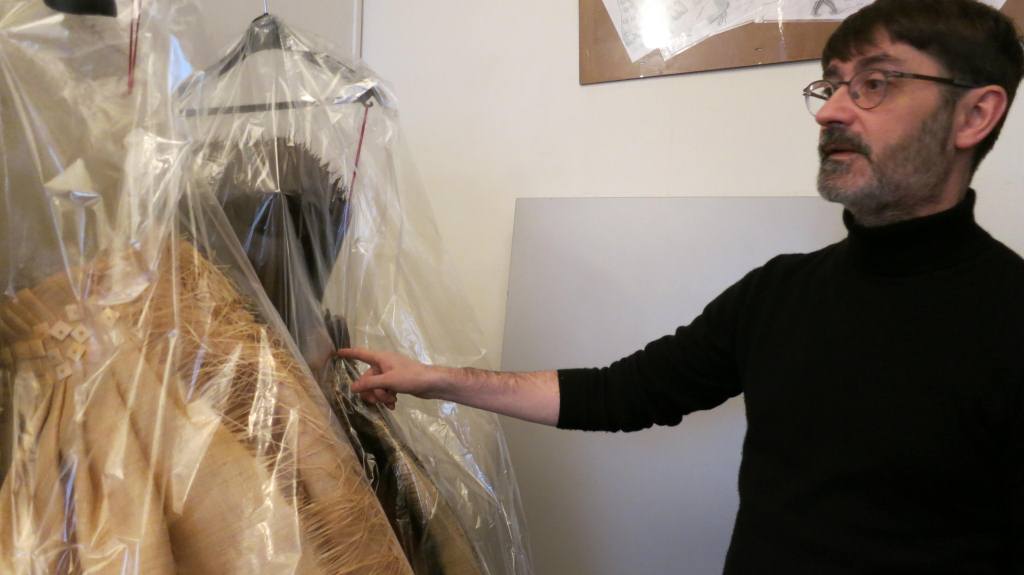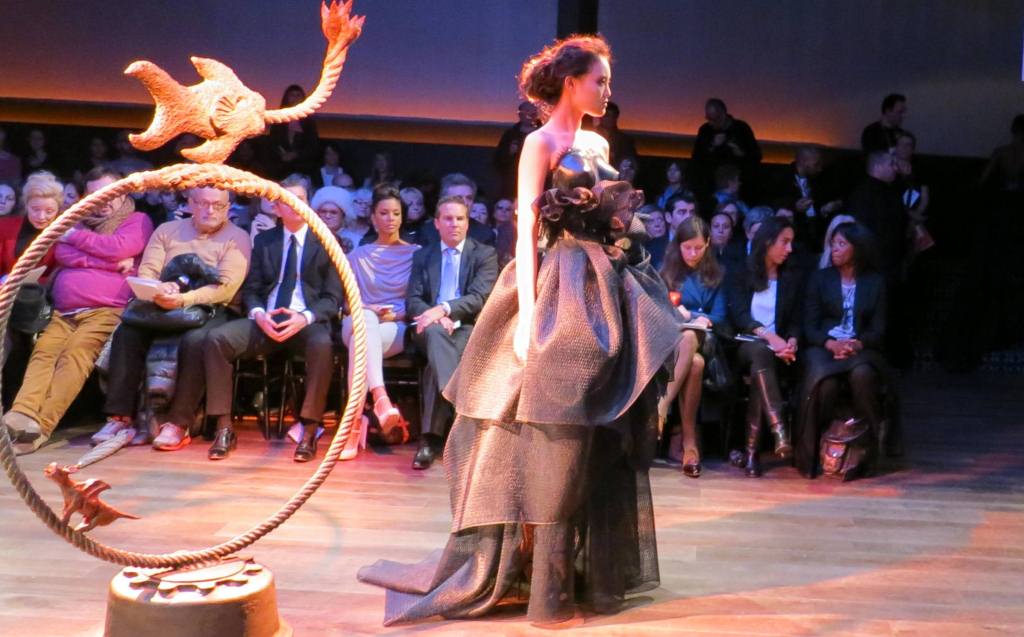An Interview with Franck Sorbier
Photo @Couturenotebook
CREATING GODDESSES
Franck Sorbier’s S/S 2012 collection seeks to explain his couture design process.
The morning after presenting his Haute Couture Summer 2012 collection in a small private night club, Franck Sorbier is in a good mood. The collection has received rave reviews in the French press, recognising his creativity and great technical couture savoir faire, and French pop singer Shy’m is already trying on several dresses, selecting one for the NRJ Music Awards, a French award music show a few days later.
At first glance, Sorbier’s conceptual collection pays tribute to goddesses of Classical Antiquity and is a design exercise on skirts. All his models, bar one, wore a fiberglass and resin bustier that looked like it had been modelled on their bare breast, and the audacious bustier were paired with neutral-coloured skirts in cotton, linen or sisal in a variety of lengths and shapes. But, as with any of Sorbier’s collections, there is much more than meets the eye.
“For several seasons now, I’d wanted to do a collection that would explain my design process. I wanted to explain how I construct my dresses, which is very much like a sculptor’s work. With the compression technique I invented, I start with small pieces of fabrics of different shapes and piece them on a mannequin without any sewing. It’s a bit like a jigsaw puzzle and you never quite know where it’s going,” he explains, referring to a technique where he gives fabrics a quality akin to papier-mache by sewing over them time and again.
Sorbier, who was inducted Grand Couturier in 2005, says he called the technique “compression” as a nod to the famous French sculptor Cesar and his compressed metal sculptures.
“So the idea of this collection is to explain how one arrives at a collection and the creative process,” he adds.
Sorbier had previously presented bustier made of paper mache in the spirit of Dada – with recycled items like old newspaper and wine corks, and even presented once a model clad in a plaster bustier with commentaries on the state of fashion tagged across it. But for this collection he upped the ante in the sexy department by using a lingerie bust as a model.
“The shape is much more suggestive and real than that of the mannequins we usually use in couture. I called the company that makes those and asked them whether they could do fibreglass tops but without finishing them, leaving the fibreglass frayed at the top to show the brut material. I also asked them whether we could try to make them in different colours,” he explains.
Sorbier says that once he has a concept for a collection he likes to reference it and “build a story around it.” In this case, having been inspired by the fiberglass bustier his story draws on influences throughout history.
“So obviously here we have the Venus de Milo, Athena and her armour, old photographs of Polynesia and Africa where you see women with bare breast and pareo, Yves Klein and his Anthropométries, when he used models as living brush, and of course there is a famous bustier that Yves St Laurent did in his collection in 1969 with Claude Lalannes,” he explained referring to a copper bustier Lalannes cast for the model Veruschka who wore it with a Yves Saint Laurent crepe georgette evening dress.
But Sorbier feels he was also influenced by French current affairs and a faulty breast implant scandal that has dominated headline news. “Creative people are like sponges, they absorb everything around them,” he remarks.
“I also like the idea of a topless bustier because it’s a bit of a countersense. It hides while revealing. And while this look is definitely daring, I don’t feel it’s indecent. The idea here was not to provoke, otherwise I would have just sent down models bare breast, though nowadays models don’t have any breast!” he quips.
Some of Sorbier’s reference points are clearer than others: One black and gold dress has a bustier with incrusted mechanical watch pieces referencing the armour of the Greek goddess Athena (look 28); other bustier are scarified with tiny pearls that are incrusted referencing motifs found to African statuettes. All the bustier were decorated by Isabelle Tartière, Sorbier’s wife and long-time business partner, except for one, which was delicately hand painted by Richard Textier with chimeras.
The collection is named ‘Ebauche’ or ‘first draft’, and many of the dresses have an “unfinished” character that suggests that this artist-couturier is still hard at work.
“I like the idea of showing the technique of couture, because after all, that is what haute couture is all about. It’s not about doing evening dresses; it’s really the technique,” he muses, while pointing out that as the collection progresses it goes from the purest to the most sophisticated while evolving from very light, pale colours toward darker ones.
Sorbier’s approach to couture can be idiosyncratic; while his pieces are genuine one-offs, they are not necessarily made from the precious materials associated with couture as he uses raffia embroidered with sea shells, linen and sisal.
“I guess I want to make a point that you can create haute couture without the strass and expensive fabrics, though I have used those in the past. My last collection was entirely made out of silk. For this collection I chose very organic materials because I felt they were working well with the overall theme of the collection. But let’s be honest too, for this collection, it’s also a question of budget and mine was very small,” he says, adding, “Sisal is actually a nice material to use for a skirt because it rises and shapes well naturally.”
Photo @Couturenotebook
Sorbier admits he doesn’t really expect clients to wear the bustier. “They are more for the overall look of the skirt. Here, I just wanted to please myself as a creator. If the client wants to keep the idea of the bustier I will do one for her in fabric or compression to match the skirt,” he explains.
But Sorbier is adamant that wearability remains extremely important to him: “Someone has to wear those dresses, and hopefully not just one time. What I like a lot amongst my clients is that they are women who want to wear these couture clothes again and again once they have bought them. I’m not designing dresses to be worn just once and end their life in a cupboard.”
He also admits to a certain amount of showmanship, “in every collection you must also have some spectacular showpieces, because images are very important today and there are so many that you get bombarded with, you somehow need to shock to be noticed. But you can shock while remaining elegant, refined and classic,” he adds.
First published in Couture by Designare Vol 2 (April 2012)









